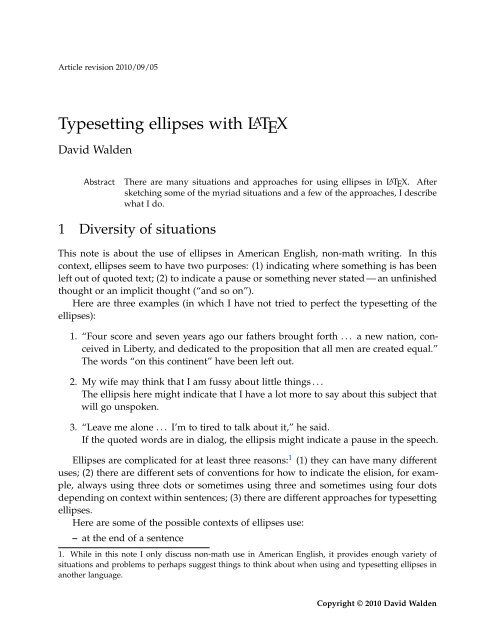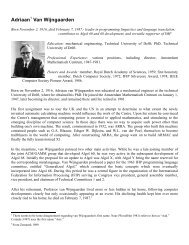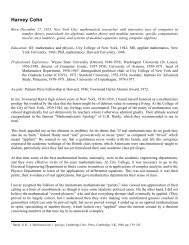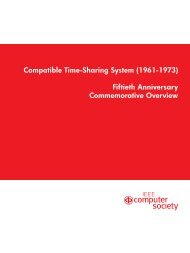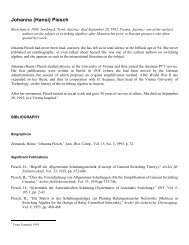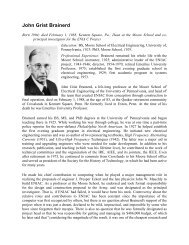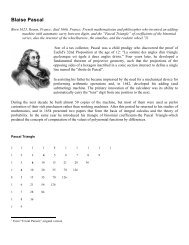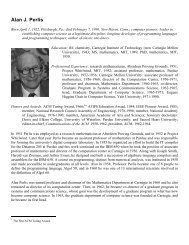Typesetting ellipses with LATEX - Walden Family
Typesetting ellipses with LATEX - Walden Family
Typesetting ellipses with LATEX - Walden Family
You also want an ePaper? Increase the reach of your titles
YUMPU automatically turns print PDFs into web optimized ePapers that Google loves.
Article revision 2010/09/05<br />
<strong>Typesetting</strong> <strong>ellipses</strong> <strong>with</strong> <strong>LATEX</strong><br />
David <strong>Walden</strong><br />
Abstract There are many situations and approaches for using <strong>ellipses</strong> in <strong>LATEX</strong>. After<br />
sketching some of the myriad situations and a few of the approaches, I describe<br />
what I do.<br />
1 Diversity of situations<br />
This note is about the use of <strong>ellipses</strong> in American English, non-math writing. In this<br />
context, <strong>ellipses</strong> seem to have two purposes: (1) indicating where something is has been<br />
left out of quoted text; (2) to indicate a pause or something never stated — an unfinished<br />
thought or an implicit thought (“and so on”).<br />
Here are three examples (in which I have not tried to perfect the typesetting of the<br />
<strong>ellipses</strong>):<br />
1. “Four score and seven years ago our fathers brought forth . . . a new nation, conceived<br />
in Liberty, and dedicated to the proposition that all men are created equal.”<br />
The words “on this continent” have been left out.<br />
2. My wife may think that I am fussy about little things . . .<br />
The ellipsis here might indicate that I have a lot more to say about this subject that<br />
will go unspoken.<br />
3. “Leave me alone . . . I’m to tired to talk about it,” he said.<br />
If the quoted words are in dialog, the ellipsis might indicate a pause in the speech.<br />
Ellipses are complicated for at least three reasons: 1 (1) they can have many different<br />
uses; (2) there are different sets of conventions for how to indicate the elision, for example,<br />
always using three dots or sometimes using three and sometimes using four dots<br />
depending on context <strong>with</strong>in sentences; (3) there are different approaches for typesetting<br />
<strong>ellipses</strong>.<br />
Here are some of the possible contexts of <strong>ellipses</strong> use:<br />
– at the end of a sentence<br />
1. While in this note I only discuss non-math use in American English, it provides enough variety of<br />
situations and problems to perhaps suggest things to think about when using and typesetting <strong>ellipses</strong> in<br />
another language.<br />
Copyright © 2010 David <strong>Walden</strong>
– <strong>with</strong>in a sentence<br />
– at beginning of a line<br />
– at the end of a line<br />
– <strong>with</strong>in a line<br />
– <strong>with</strong> other punctuation after the ellipsis<br />
– <strong>with</strong> other punctuation before the ellipsis<br />
– <strong>with</strong>out other punctuation before or after the ellipsis<br />
Lots of combinations of those and other situations also can happen.<br />
2 Different conventions<br />
On pages 82–83 of his The Elements of Typographic Style, 2 Robert Bringhurst gives a<br />
sketches covering some of the conventions for using <strong>ellipses</strong>: 3<br />
Most digital fonts now include, among other things, a prefabricated ellipsis<br />
(row of three baseline dots). Many typographers nevertheless prefer to make<br />
their own. Some prefer to see the three dots flush ... <strong>with</strong> a normal word<br />
space before and after. Other prefer . . . to add thin spaces between the dots.<br />
Thick spaces (M/3) are prescribe by the Chicago Manual of Style, . . . . In most<br />
cases the Chicago ellipsis is much too wide.<br />
Flush set <strong>ellipses</strong> work well <strong>with</strong> some fonts and faces but not <strong>with</strong> all. . . .<br />
At small text sizes . . . it is generally best to add space . . . between the dots.<br />
Extra space may also look best in the midst of light, open letterforms, . . . , and<br />
less space in the company of a dark font, . . . , or when setting in bold face. . . .<br />
In English . . . , when the ellipsis occurs at the end of a sentence, a fourth<br />
dot, the period, is added and the space beginning the ellipsis disappears. . . .<br />
When the ellipsis combines <strong>with</strong> a comma, exclamation mark or question<br />
mark, the same typographic principle applies. Otherwise a word space is<br />
required fore and aft.<br />
However, the Bringhurst summary leaves out some common conventions. For instance,<br />
pages 292–296 of my copy of Chicago Manual of Style 4 starts by giving two main<br />
conventions for the form of <strong>ellipses</strong>: (1) always only three dots, and (2) four dots at<br />
the end of sentences (or three dots and another punctuation mark, as described by<br />
Bringhurst) and three dots elsewhere. The latter is the manual’s preferred convention.<br />
2. Version 3.1, Hartley & Marks, Publishers, Vancouver, BC, 2005<br />
3. The first two instances and the last instance of an ellipsis in this quote are part of Bringhurst’s text.<br />
The rest of the <strong>ellipses</strong> are by me to indicate my elisions from the Bringhurst quote.<br />
4. I’m looking at the 13th edition and not the latest 14 edition.<br />
2
Ellipses in block quotes also provide additional circumstances beyond those mentioned<br />
in Bringhurst’s sketch.<br />
The are a number of useful on-line discussions of the use of <strong>ellipses</strong>, for example,<br />
– in the Wikipedia: http://en.wikipedia.org/wiki/Ellipsis<br />
– in Doc Scribe’s Guide to research styles, where you can lookup the approaches<br />
recommended in five well known style guides (AMA, APA, ASA, Chicago, and<br />
MLA): http://www.docstyles.com/<br />
3 Standard tools versus hand crafting<br />
Just using \dots or \ldots in <strong>LATEX</strong>is often not enough to address some of the potential<br />
needs mentioned in the previous sections. 5<br />
Also, naive use of \dots apparently has a problem that Peter Heslin’s ellipsis style<br />
(http://www.ctan.org/tex-archive/macros/latex/contrib/ellipsis/) works on fixing.<br />
As Heslin says,<br />
There is a problem in the way <strong>LATEX</strong> handles <strong>ellipses</strong>: it always puts a tiny bit<br />
more space after \dots in text mode than before it, which often results in the<br />
ellipsis being off-center when set between two other things.<br />
It is worth reading the documentation of Heslin’s package, 6 which aos describes some of<br />
the issues relating to using <strong>ellipses</strong>. The package also allows one to specify the Chicago<br />
or MLA style and to specify the spacing between dots (e.g., in terms of an em) in an<br />
ellipsis.<br />
Another package is lips.sty (http://www.tex.ac.uk/ctan/macros/latex/contrib/<br />
frankenstein/lips.sty), which Heslin suggests one use if one wants the full Chicago<br />
style.<br />
With so many possibilities and needs, it is not surprising that, as Bringhurst says,<br />
“Many typographers nevertheless prefer to make their own.” It is hard for me to imagine<br />
a package <strong>with</strong> sufficient capabilities and options for everyone.<br />
4 My approach<br />
My approach has been to define a few macros to handle common situations for using<br />
<strong>ellipses</strong> in the writing I do. These also implement my own preferences, such as for interdot<br />
spacing and spacing before and after an ellipsis. I have used a couple of versions of<br />
these.<br />
5. Also see the appendix.<br />
6. http://www.ctan.org/tex-archive/macros/latex/contrib/ellipsis/ellipsis.pdf<br />
3
Version 1<br />
The following definitions were sufficient for the Breakthrough Management book I coauthored<br />
and typeset. I used the Minion typeface for this book. The comments in<br />
the follow code provide the relevant explanations.<br />
%dots for main text<br />
\def\bigdotsspace{3pt}<br />
%three dots<br />
\def\mydots{\hbox{\hspace{\bigdotsspace}.\hspace{\bigdotsspace}.<br />
\hspace{\bigdotsspace}.\hspace{\bigdotsspace}}}<br />
%I like the same size space on each side of the ellipsis as<br />
% is between the dots of the ellipsis<br />
%period and three dots = four altogether<br />
\def\fmydots{\hskip0pt{}\hbox{.\hspace{\bigdotsspace}.<br />
\hspace{\bigdotsspace}.\hspace{\bigdotsspace}.\hspace{\bigdotsspace}}}<br />
%And the same size space after a period and before 3 dots<br />
%dots <strong>with</strong> only beginning space -- no following space<br />
\def\mydotsnfs{\hbox{\hspace{\bigdotsspace}.\hspace{\bigdotsspace}.<br />
\hspace{\bigdotsspace}.}}<br />
%I used this def <strong>with</strong> an ellipsis and following comma, etc.<br />
%dots for block quote text, which is smaller than main text<br />
\def\smalldotsspace{2pt}<br />
%three dots <strong>with</strong>out end spaces<br />
\def\minsmalldots{\hbox{.\hspace{\smalldotsspace}.<br />
\hspace{\smalldotsspace}.}}<br />
%three dots -- small my dots<br />
\def\smydots{\hbox{\hspace{\smalldotsspace}\minsmalldots<br />
\hspace{\smalldotsspace}}}<br />
%period and three dots = four altogether<br />
\def\fsmydots{\hskip0pt{}\hbox{\hspace{.3pt}.\hspace{\smalldotsspace}<br />
\minsmalldots\hspace{\smalldotsspace}}}<br />
4
Version 2<br />
I am using the following set of definitions <strong>with</strong> the book I have compiled about the<br />
technology history of the company Bolt Beranek and Newman and that I am now typesetting.<br />
This book uses the Lucida Bright typeface. For this second book I had learned<br />
about doing things in terms em which varies <strong>with</strong> font size, e.g., among main, footnote,<br />
and block quote text. My decisions in the following definitions are only about what looks<br />
good to me, not about the conventions of a particular style manual. (The comments in<br />
the following code provide the relevant explanations.)<br />
\def\sentencespace{\unkern\spacefactor=3000 \space\ignorespaces}<br />
%\def\fourdots{\unskip\kern\fontdimen3\font.\kern.1667em\ldots\sentencespace{}}<br />
%tried this but didn’t use it<br />
\def\fourdots{\hbox{.\hspace{.33em}.\hspace{.33em}.\hspace{.33em}.\,}}<br />
%<strong>with</strong> an end-of-sentence ellipsis I use a thin, not word, space<br />
\def\fourdotstightright{\hbox{.\hspace{.33em}.\hspace{.33em}.\hspace{.33em}.}}<br />
%sometimes I don’t want the trailing thinspace, e.g., at end of line<br />
%\def\threedots{\unskip\ \ldots\unkern{}}<br />
%tried this but didn’t use it<br />
\def\threedots{\hbox{\,.\hspace{.33em}.\hspace{.33em}.\,}}<br />
%for a non-end-of-sentence ellipsis<br />
\def\threedotstightleft{\hbox{.\hspace{.33em}.\hspace{.33em}.\,}}<br />
%for beginning of line, e.g., in a block quote<br />
\def\threedotstightright{\hbox{\,.\hspace{.33em}.\hspace{.33em}.}}<br />
%for the end of line, e.g., in a block quote<br />
\def\fnfourdots{\fourdots{}}<br />
%for use in a footnote -- I originally thought I might need<br />
% a different definition, but then I was happy <strong>with</strong> the<br />
% main text ratios<br />
\def\fnthreedots{\threedots{}}<br />
%ditto<br />
5
Conclusion<br />
It is easy to see how my set of definitions could be adapted to using word or sentence<br />
spaces before and after an ellipsis while using some other appropriate inter-dot spacing,<br />
or to adapt the definitions to other traditional or personal conventions. For instance,<br />
\def\fourdots{\hbox{.\hspace{.33em}.\hspace{.33em}.\hspace{.33em}}. }<br />
%sentence space after four dots<br />
I am also sure that there are better approaches than mine for handling a variety<br />
of ellipsis situations in <strong>LATEX</strong>, or at least better ways to do what I am doing (perhaps<br />
automatically detecting whether an ellipsis is at the beginning or end of a line and thus<br />
eliminating the need for those definitions).<br />
I am interested in hearing about other approaches and critiques about my approach,<br />
and I’d be glad to add an appropriate set of annotations here.<br />
Appendix<br />
In the file latex.ltx, I found the following definitions.<br />
\DeclareTextCommandDefault{\textellipsis}{%<br />
.\kern\fontdimen3\font<br />
.\kern\fontdimen3\font<br />
.\kern\fontdimen3\font}<br />
\DeclareRobustCommand{\dots}{%<br />
\ifmmode\mathellipsis\else\textellipsis\fi}<br />
\let\ldots\dots<br />
6


